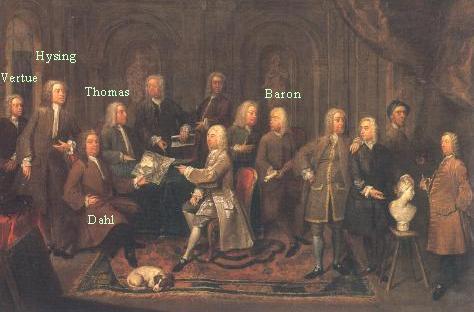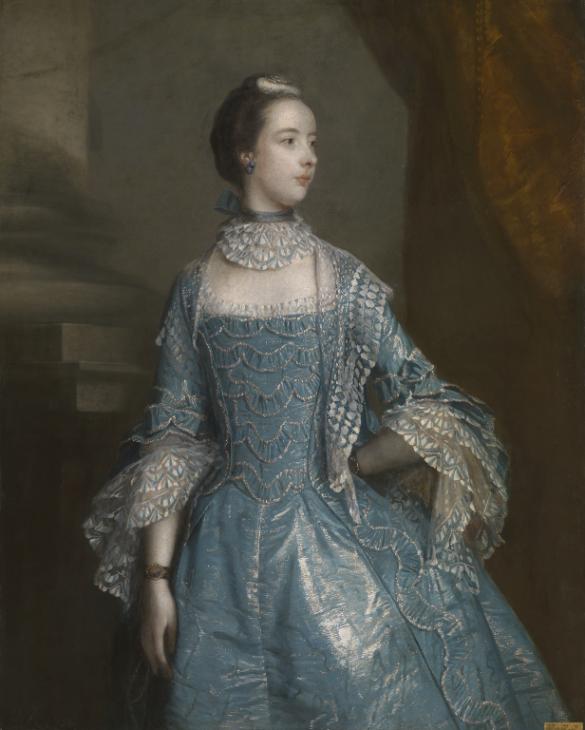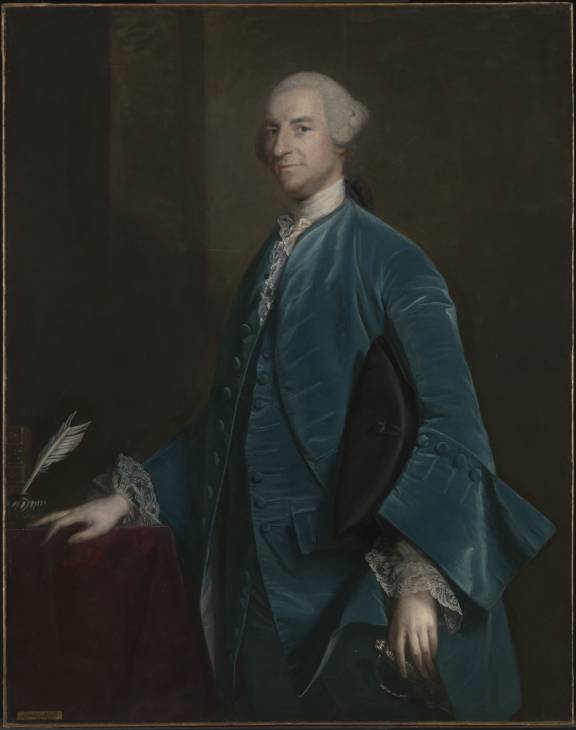People of Fashion
Chapter Two.
This is a section about the People of Fashion. It may sound like it should be exactly as the previous chapter but where as that dealt with Court Fashion and the royal family, this chapter now branches off into the families that made up the Court and also those who could afford the lifestyle that went with such clothes. She describes the parties of this group as “The nobility held their own courts, full-dress receptions as splendid as those of court.”
A.Buck uses this above painting to show Men’s fashion in the 1730’s and picks out some of the key figures (not necessarily the names on the above painting). What’s particularly interesting for us is her pointing out that all the wigs shown in this painting are variants of the Campaign Wig – our wig knowledge is useless!
In this chapter, Buck begins with talking about mantua’s vs sack backs and on p.26 she states: “In women’s dress the sack-back gown was replacing the Mantua at full dress balls and assemblies during the 1730’s.” This new fashion could be made more formal by’the loose back being lengthened into a train and by it’s fabric and trimming…’ She does mention, however, a loose description of something she calls the ‘Court Gown’. Whether she means the Stiff Bodied Gown used for super-formal occasions (unlikely we thinks…) or she is talking about the Mantua which had begun to be replaced back in 30’s and is still being worn side by side the sack in the 50’s when she uses this term of a ‘Court Dress”. Sorry, we can’t be more clear as we’re a little unsure ourselves. Or it could mean a Sack still but one that has been made up with expensive fabric and even more expensive trim and hence why Lady Anson wanted to lift the decoration for use on another gown. But that doesn’t answer the next quote where, in 1776,’ Lady Polwarth ordered 20 yards of silk for a ‘highly trimmed’ gown for court, “for it will make a good sack by and by.”. Grrr… Perhaps she is meaning for it to be made up into only a sack and the quote is making it sound like 2 garments or it could be that the ‘gown for court’ is a ‘mantua’ (this is the 70’s though – were mantua’s still being worn??) Buck then goes onto say ‘Full-trimmed and trained the sack was a formal dress, but it appeared almost everywhere in it’s plainer version.’ (p.26). Hoops could also, according to Buck (p.27) turn a sack into a formal gown. Buck then goes onto mention how Polonaises replace the Sack in the 70’s. So perhaps it was a polonaise that Lady Polwarth was making up first? Except that polonaises, as far as we understand, weren’t ‘highly trimmed’.
O.k, Other Interesting Facts Include:
– “Ladies who intend to dance a minuet wear large hooped dresses but others do not.” A rule that applied to Bath in 1761.
– However ladies were also not dancing in hoops in the 50’s (p.27)
– 1780’s were rich with trimmings – it’s interesting because you don’t really think of general 80’s dresses having much trimming compared to the 50’s but perhaps in Court wear, those wonderful bizarrely trimmed French fashion plates do really coming into a league of their own.
– In amongst the fashions in wig wearing, there was a brief interlude in the 60’s of wearing natural hair.
From a tailoring point of view, she makes a fascinating comment on p.31 that “By the middle of the century the coat was losing it’s stiffness and the pleats of it’s skirts, now unpadded, were set further back.” This is a great quote. Firstly she details the distinct changes to the silhouette of men’s fashion – stating that the 40’s look of wide hips was growing out of fashion and a more streamline look beginning to creep in. And secondly, how this was achieved = by no longer padding the skirts of the jkt and by moving the pleats round to the back a little more. We’ve just been studying a couple of coats at the Museum of London (images for personal use only guys – sorry!) but the tailoring behind the pleats was incredible – horsehair canvas, wadding, linen: it was all worked to create that pleated movement. The 3 jkts we looked at were dated Blue Coat – 1776-99 and yet still had wadding and strengthener placed in to support folding. This doesn’t mean Buck is wrong but it had been toned down and probably altered in it’s purpose as to which shape and look to create. Apparantly the 40’s could even use wire to hold out the pleats. The wide, femine hips of the 40’s had definitely gone out of fashion (see Hogarth page for more info)- no doubt – by the time we get to the Museum of London’s jkts o the wadding wasn’t used any longer to create that curvaceous shape but rather to make the folds of the pleats smooth and solid looking. (Perhaps – this still needs more research)
She describes Breeches in a really good way – especially for an over view of the centurys development of this garment. On p.31 Buck writes “Breeches, almost invisible at the beginning of the century, were gradually revealed bye the shortening of the waistcoat and the backward movement of the coat and were cut high to meet the riding line of the waistcoat. With this emergence of the breeches from obscurity a flap or fall-front was added to cover the vertical front fastenings, sometimes made as a narrow central section, sometimes extending from seam to seam over the whole front.” (see Cunnington’s Handbook of English Costume for a detailed drawing into the variations and our page on a pair of breeches from the Bath Fashion Museum.)
There’s also an interesting quote from Frederick Robinson that shows a little of the specificness of clothing and how some things just couldn’t be dressed down. “At this time of year in England a dress coat is wanted for nothing but court, nor do I foresee the occasion I cna ever have for putting on my green poplin again.” Here Buck explains that he’s talking about a suit he bought in Paris. In 1779 the same Mr Robinson explains that “there is rather an affection of negligence and men go to the opera in plain frocks and white waistcoats.” (p.32) Which is good to know – a little spurt of fashion!
Another Tailoring bit of interest, still on page 32 is Buck’s description of the Frock coat – being ‘in the first half of the century was a coat for easier informal wear, distinguished by it’s turn-down collar and unstiffened pleats. (Italics ours) It was usually of plain cloth; if there was trimming it was limited to a binding of gold of silver lace.” By the mid 40’s the frock had become to be more dressed with ornamentation and therefore worn for less informal occasions and by 1761 it was being worn by Lord Huntingdon at a ball at Norfolk House but he’d pretended to come in from’the country’. She goes into fascinating detail about this need for an excuse to be wearing informal costume.
We could be here for some time – it’s a heck of a chapter!
Another Interesting fact is that Round Shoulders were still a problem back then. We’d tended to think along the lines of the Stays really pulling the woman’s back into a shorter XB (Cross Back Measurement) than we have today and although this could also be the case we have a quote from Earl Orrery in 1722 that ‘their shapes may possibly be fine but of this no certainty for they wear sac’s or robes de chambres that will hide the roundest of shoulders.’ This was at a time when the sacs were loose and you can see examples of them in many of Wattueau’s paintings. In this section here she also describes the turning to ‘France as the source of new fashions’ and talks again at how the French court wore the ‘Stiff Bodied Gown‘ until the revolution but also wore a loose neglige type garment that never found favour in the English wardrobe – perhaps we didn’t have the weather.
More Interesting facts:
– But one that surprised us is the ease at which the rich ordered garments that weren’t made precisely for them. On p.33 Lady Anson had a dress made on a lady judged to be about her size and has a wonderful list of things that accompanied the gown. “French trimming, with tippet, stomacher, sleeve knot, Ruffles etc etc , all properly suited to it.”
– In 1749 The French Ambassadress wore ‘her hair is curled in small ringlets round her face, pinned up behind a cap not near so big as your hand and nothing round her neck.’ and again ‘the short caps you mentioned are only worn by young people who curl their hair after the French Ambassadress’ fashion.’ – 1751. These aren’t the same small caps with lappets that she writes about disappearing from main fashion but a subtle new cap – it’d be interesting to scour the 1750’s images and particularly research this ‘French Ambassadour’ to see if we can see this fashion in portraiture. This is lovely! She then goes on to write that there isn’t a ‘decent old woman left, everybody curls their hair, shews their neck and wears pink.’ What a wonderful little glimps into this 1750’s fashion.
– A good quote on the french view of English Fashions: ‘The women use no paint and are always laced.’ There is a portrait of Mdm d’Epinay where we’ve always thought she didn’t look like she was wearing stays.
– She has a good section on Masquerades and what they were and how they were considered – definitely worth a read. Though as one group of ladies dress up as Counrty Girls they use ‘Round eared caps to create the effect – interesting! And there’s a lovely bit where one girl realises she’s going to have to go without wearing a hoop: ‘It falls not with any of my notions of the pastoral dress of Arcadia – I am not to have a hoop – they wore not hoops in Arcadia.’ Brilliant.
– She updates us on the use of sacks as informal Undress, saying that: “The sack was adopted, not in it’s original loose form but in it’s more formal version, with the bodice-fronts cut and shaped to the figure.” This kind of describes the difference between a more fitted sack and the looser earlier ones which is very interesting. (p.40)
–






